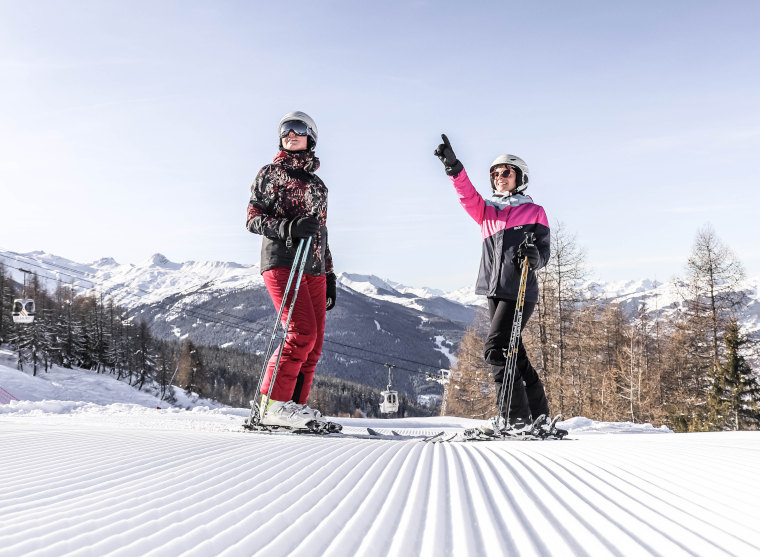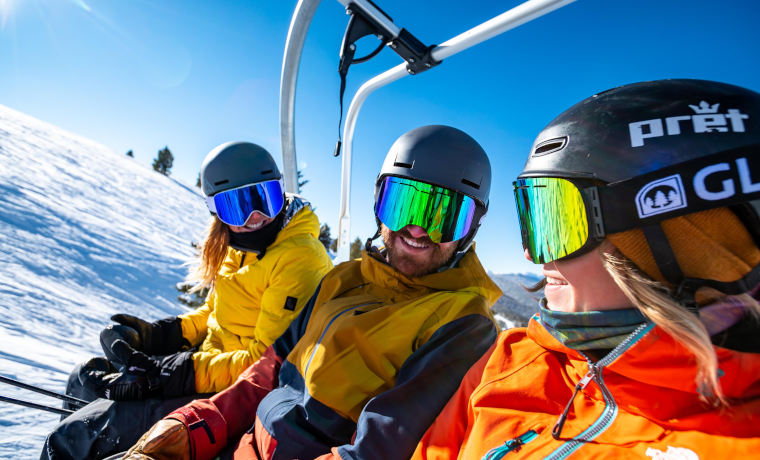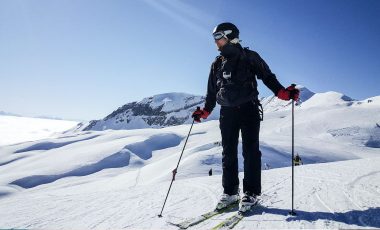Winter generally isn’t the first season you think of for outdoors activity and exercise. It’s a season of cold and wet, with more dark hours than light, meant for cosying up on the sofa and staying indoors: the hibernation season! For outdoor lovers, it’s a challenging time of year to know what outdoor activity to do and, frankly, work up the enthusiasm to actually go outside!
Skiing, however, is an exception. It’s a true winter pursuit and is one of the oldest and most popular winter sports around. And, in our opinion, something everyone should try!
- Who is skiing it for?
- Where can I go skiing?
- What to expect from your first time skiing
- How to get started
- What to wear skiing
- How to ski: tips for beginners
Skiing has been around for a long time, believed to date back to 6000 BC in Russia when skis were used as a survival tool to enable man to travel for hunting during the winter months. It started to grow in recreational popularity in the 1880’s across Europe. Then, in 1924, Nordic skiing was featured in the first Winter Olympic Games. Alpine skiing, the most popular form of skiing today, coming to fruition in the 1936 Winter Games.
So, if we’ve sparked your interest in learning how to ski or want a skiing beginners guide, you’re in the right place, keep reading! This advice comes from SnowSkool who provide ski instructor courses and snowboard instructor courses.

Who is skiing it for?
The short answer, anyone! Of-course, two large aspects of skiing are heights and the cold, so if you’re someone who hates the cold or has a real fear of heights, then skiing might not be your number-one choice. But, if you love the outdoors, and like a bit of physical activity, there’s every reason you’ll thoroughly enjoy skiing.
Anyone who likes nature and the outdoors will appreciate that mountains are a spectacular natural wonder and reason alone to go skiing!
You can learn to ski at any age, so don’t be put off if you’re a beginner at 30. There are plenty of options for learning how to ski, whether you do it in the mountains or closer to home. Plus, skiing is a great thing to do as a family and can be loads of fun in large groups of families or friends.
Where can I go skiing?
Where to ski is easy. Skiing is a global sport and, as a result, is possible almost anywhere in the world. Europe, unsurprisingly, has the largest number of resorts being the birthplace of skiing. North America, Japan and New Zealand are the next most established ski areas. South America and the Middle East are up-and-coming areas, seeing a growing popularity for skiing. So really, the world is your oyster!
For a total beginner skier, unless you live near mountains, it might be a good idea to start learning locally. Find your nearest indoor ski slope or dry slope, book a lesson and get a feel for skiing. You don’t want to spend loads of money booking a holiday and discover once you’re out there it’s not for you!
When booking a ski trip look for a ski resort that’s right for you. Some resorts are more family friendly with lots of green runs and others more challenging with mainly blue and red slopes. So, do some research before you book; there’s plenty of information on resorts slope difficulty online. Below is a guide on slope difficulty rating systems:
EUROPE:
| Green: | Easy |
| Blue: | Intermediate |
| Red: | Difficult |
| Black: | Very difficult |
NORTH AMERICA, NZ, AUS:
| Green circle: | Easy |
| Blue square: | Intermediate |
| Black diamond: | Difficult |
| Double black diamond: | Very difficult |
JAPAN:
Uses both European and North American systems. It depends on the resort.

What to expect from your first time skiing
Mountains
- Breath-taking scenery and views and beautiful clear blue sky and sunshine days.
- Cold temperatures and sometimes extreme weather conditions – minus-Celsius temperatures, snowstorms, strong winds, bad visibility.
- Altitude and height – It can sometimes take a day or two to acclimatise to the altitude if you are not used to it. There will be large drops, especially on lifts, not good for those who fear heights or suffer from vertigo.
- Snow – obviously there’s lots of it, but it comes in a variety of conditions; powder, hard packed, icy, slushy, crust etc. Getting lessons will help you learn how best to deal with each one.
Skiing itself
- The feeling – once you get the knack of skiing it’s a fantastic feeling and you’ll inevitably catch the skiing bug!
- Lifts – there are a variety of ski lifts to get used to: button and chair lifts, cable cars, T-bars, gondolas, magic carpets. As a beginner skier, lifts can be a little daunting and tricky, but you’ll soon gain confidence, plus they’re always manned with someone to help you.
- Mountain food and restaurants – types of mountain cuisine can be quite different depending where you are in the world. Whether you think of lunch purely as fuelling up or as a leisurely, important break there is nothing like sitting on the deck of a restaurant in the sun surrounded by snow with a fantastic view.
- It’s tiring – being a sport, skiing is naturally physically tiring; your legs work the hardest but the cold makes your body work constantly to stay warm and being at altitude means everything takes more effort. Skiing for beginners is especially tiring as technique is more taxing on the legs and you’re concentrating harder to stay upright! But, it’s the most rewarding kind of tiredness and worth the trade-off for the acquisition of a new skill.
How to get started
Skiing is quite a unique sport. There are few crossovers from other sports that can aid you in skiing, unlike snowboarding where surfing and skateboarding use similar techniques, providing transferable skills. So, if you’re a complete beginner skier everyone is on level pegging regardless of how sporty you are, which is nice! It also means skiing is not necessarily a sport you can just rock up to and hope you’ll just get the hang of it!
So…
Question: how to ski for the first time?
Answer: get lessons!
Taking lessons in the mountains is obviously the best way to learn skiing, but if you don’t live near mountains it’s a good idea to go to your closest dry slope or indoor ski slope for some lessons. Doing so before your holiday will give you a basic understanding and feel for skiing.
For skiing you need quite a lot of equipment: skis are the obvious ones but ski boots, ski socks, gloves, jacket, trousers and a helmet are all needed too. You need not worry though; you don’t have to buy it all!
Skis, ski boots, poles and helmets can be rented in all resorts, indoor centres and dry slopes, some resorts also offer ski goggle rental but not all. Some indoor/dry slopes have ski jacket and trouser rental, which is really useful for your first few lessons, saving you having to buy them. Waterproof gloves and ski socks are the only things you must have before going to an indoor/dry slope.

What to wear skiing
As already discussed, skiing is an equipment/clothing heavy sport. Having the correct gear is very important in skiing as it’s all designed to protect you from the mountain elements. Your clothing must keep you warm in sub-zero temperatures, dry from the snow and be windproof, shielding you from freezing, strong winds. Goggles are vital for reducing the sun’s glare on the snow and providing better visibility on bad weather days.
So, the skiing beginners’ guide for what to wear when skiing in the mountains is:
Ski Jacket
- Ski Trousers
- Thermal base layers
- Ski socks
- Gloves (must be waterproof and warm)
- Helmet – can be rented in resort
- Goggles
Extra non essentials but useful:
Neck buff
- Thermal leggings
- Sunglasses
- Hat to go under helmet
Now, I know what you’re thinking, this is going to be expensive and you haven’t even gotten to the mountains yet! Granted, there’s no shying away from the fact that skiing isn’t a cheap hobby, but you really don’t need to spend a fortune. there are loads of inexpensive ski brands out there. Borrowing clothes like ski trousers is a good money saver too.
For more information read this guide to ski and snowboard clothing.

How to ski: tips for beginners
There’s a perception that with skiing that you’ll only get to a good standard if you started skiing from the age of six, but that’s not true. Sure, at a young age you are more fearless and don’t have so far to fall, but learning how to ski for the first time has no age limit and at an older age you’re more coordinated and will progress faster. To help you get there here are a few tips about skiing techniques for beginners learning snowplough.
Snowplough, or sometimes known as ‘pizza’ due to the triangle shape your ski make, is the first technique every beginner skier will use.
The bigger your snowplough or the bigger the pizza slice, the slower you will go. Enlarging your snowplough is the best way as a beginner skier to control your speed, so if you need to slow down suddenly, quickly push the back of your skis out to make a big snowplough.
Don’t sit back on your skis, you want to bring your hips forward so they’re roughly in line with your feet. You want your weight in the middle of your skis not on the back as this will make you less balanced and increase your speed.
A tip for downhill skiing basics: When turning in snowplough to help you understand how and where to distribute your weight try this trick. When going into your turn, reach the same arm as your outside leg down towards the outside of your boot bindings. This leaning motion will move your weight onto your outside turning leg, giving you more control in your turn.
Now you have all the information you need on skiing for beginners, what are you waiting for, get out there and learn to ski!



